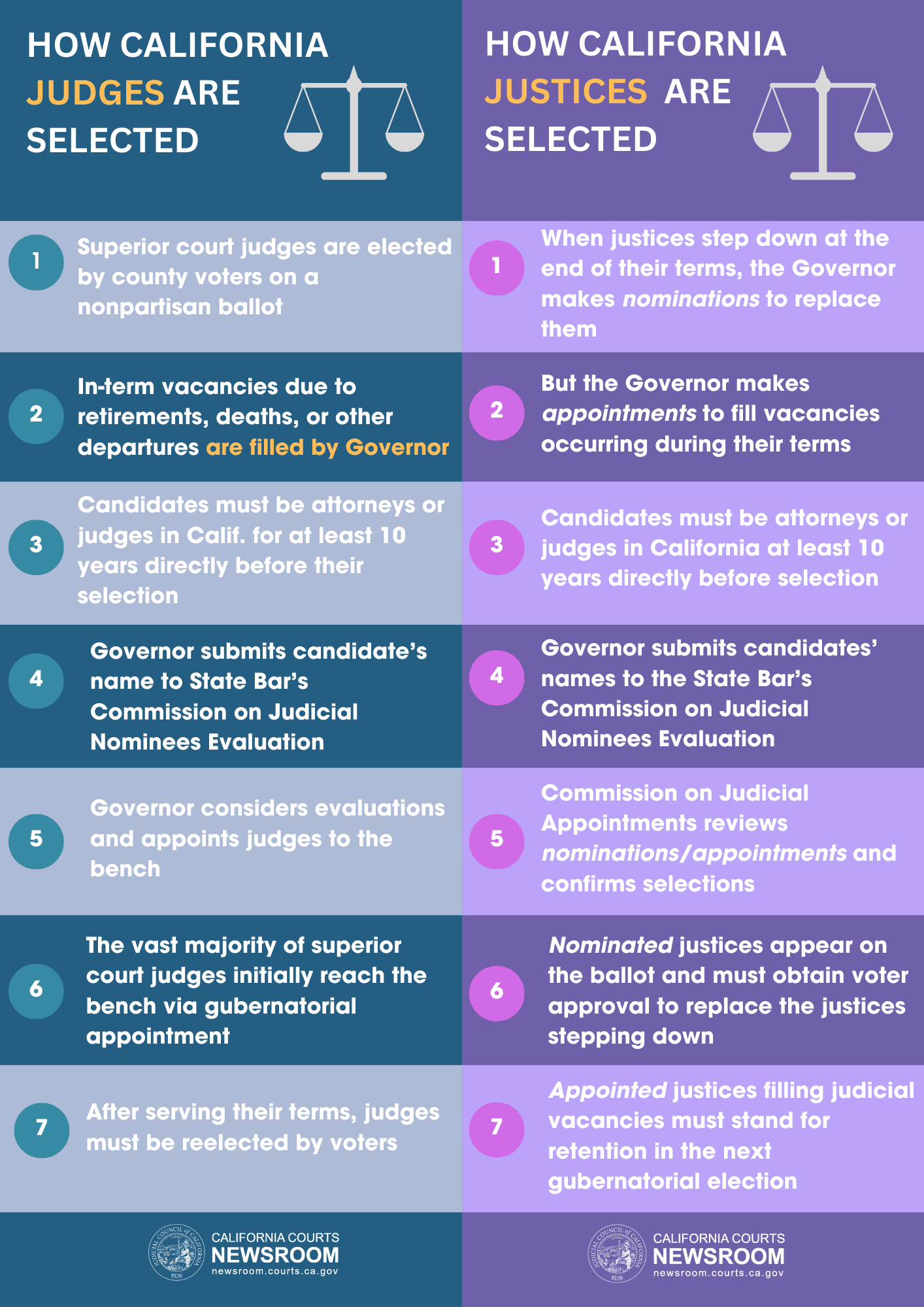Judicial Selection: How California Chooses Its Judges and Justices
The California court system consists of the local superior courts in each of California’s 58 counties, the 6 districts of the Court of Appeal, and the Supreme Court. Following is a summary of how judges and justices get to their positions on these courts.
Superior Court Judges
The Legislature has constitutional authority to determine the number of judgeships in each of the 58 superior courts. Superior court judges serve six-year terms and are elected by county voters on a nonpartisan ballot at a general election during even-numbered years. Vacancies occurring during those terms—due to retirements, deaths, or other departures—are filled through appointment by the Governor. The vast majority of superior court judges initially reach the bench via gubernatorial appointment.
The California Constitution establishes when a seat goes on the ballot following a vacancy, and when an appointed judge must first stand for election. If an incumbent judge, including an appointee, is running unopposed, their name does not appear on the ballot.
All judges, whether elected initially to an open seat or appointed by the Governor and then elected, serve six-year terms that commence in early January following their election. All elected judges must stand for reelection at the end of their six-year term.
A superior court judge must have been an attorney admitted to practice law in California or served as a judge in California for at least 10 years immediately preceding election or appointment. The State Bar’s Commission on Judicial Nominees Evaluation investigates and evaluates prospective nominees’ background and qualifications.
Supreme Court and Court of Appeal Justices
The Legislature has constitutional authority to determine the number of districts and justices of the Court of Appeal.
Appellate justices are appointed by the Governor and confirmed by the Commission on Judicial Appointments, which consists of the Chief Justice, the Attorney General, and the presiding justice of the affected district or, if there are 2 or more presiding justices, the one who has presided longest.
Appellate justices serve 12-year terms, commencing in early January following their election. The 12-year term essentially attaches to the seat, meaning that a vacancy does not change the election cycle for that seat. Appellate elections occur every four years, coinciding with gubernatorial elections, and each appointed justice must stand for election in the first such election at which there was sufficient time for the appointee to file papers to run for the seat. This means that following their initial election, an appointee will earn the right to hold the seat for either 12, 8, or 4 years, depending on when during the 12-year election cycle the appointment occurred. Thereafter, any previously elected incumbent who seeks reelection necessarily will seek election to a 12-year term.
Appellate elections are “retention” elections, meaning the voters are asked whether the individual should or should not be elected. The elections are not contested, and other individuals may not run for the seat.
When California Supreme Court or Court of Appeal justices choose not to seek reelection near the end of their 12-year terms, the Governor nominates individuals to appear on the ballot to replace them pending voter approval. These nominees must have been an attorney admitted to practice law in California or served as a judge in California for at least 10 years immediately preceding selection. Unlike the scenario under which the Governor nominates a successor for a justice who will complete their term but not seek reelection, judicial vacancies occurring during an elected term—due to retirements, deaths, or other departures—are filled through appointments by the governor.
Like appointments of judges to the superior courts, the State Bar’s Commission on Judicial Nominees Evaluation investigates and evaluates prospective justices’ backgrounds and qualifications.
California Constitution section on judicial vacancies, appointments, elections

Removal from the Bench
The California Commission on Judicial Performance oversees the professional and personal conduct of judges and justices. All judges and justices must comply with the California Code of Judicial Ethics, which contains standards for ethical conduct. Judges or justices that violate any of those standards may be disciplined and even removed from office, making them no longer eligible for election by the voters.

